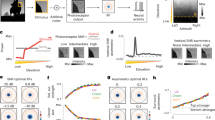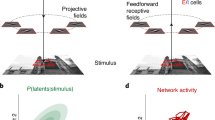Abstract
To extract important information from the environment on a useful timescale, the visual system must be able to adapt rapidly to constantly changing scenes. This requires dynamic control of visual resolution, possibly at the level of the responses of single neurons. Individual cells in the visual cortex respond to light stimuli on particular locations (receptive fields) on the retina, and the structure of these receptive fields can change in different contexts1,2,3,4. Here we show experimentally that the shape of receptive fields in the primary visual cortex of anaesthetized cats undergoes significant modifications, which are correlated with the general state of the brain as assessed by electroencephalography: receptive fields are wider during synchronized states and smaller during non-synchronized states. We also show that cortical receptive fields shrink over time when stimulated with flashing light spots. Finally, by using a network model we account for the changing size of the cortical receptive fields by dynamically rescaling the levels of excitation and inhibition in the visual thalamus and cortex. The observed dynamic changes in the sizes of the cortical receptive field could be a reflection of a process that adapts the spatial resolution within the primary visual pathway to different states of excitability.
This is a preview of subscription content, access via your institution
Access options
Subscribe to this journal
Receive 51 print issues and online access
$199.00 per year
only $3.90 per issue
Buy this article
- Purchase on Springer Link
- Instant access to full article PDF
Prices may be subject to local taxes which are calculated during checkout





Similar content being viewed by others
References
Knierim, J. J. & van Essen, D. C. Neuronal responses to static texture patterns in area V1 of the alert macaque monkey. J. Neurophysiol. 67, 961–980 (1992).
Sillito, A. M., Grieve, K. L., Jones, H. E., Cudeiro, J. & Davis, J. Visual cortical mechanisms detecting focal orientation discontinuities. Nature 378, 492–496 (1995).
Zipser, K., Lamme, V. A. & Schiller, P. H. Contextual modulation in primary visual cortex. J. Neurosci. 16, 7376–7389 (1996).
Gilbert, C. D. Adult cortical dynamics. Physiol. Rev. 78, 467–485 (1998).
Steriade, M., McCormick, D. A. & Sejnowski, T. J. Thalamocortical oscillations in the sleeping and aroused brain. Science 262, 679–685 (1993).
McCarley, R. W., Benoit, O. & Barrionuevo, G. Lateral geniculate nucleus unitary discharge in sleep and waking: state- and rate-specific aspects. J. Neurophysiol. 50, 7980–818 (1983).
Funke, K. & Eysel, U. T. EEG-dependent modulation of response dynamic of cat dLGN relay cells and the contribution of the corticogeniculate feedback. Brain Res. 573, 217–227 (1992).
Sawai, H., Morigiwa, K. & Fukuda, Y. Effects of EEG synchronization on visual responses of cat's lateral geniculate relay cells: a comparison among Y, X and W cells. Brain Res. 455, 394–400 (1988).
Lo, F. S., Lu, S. M. & Sherman, S. M. Intracellular and extracellular in vivo recording of different response modes for relay cells of the cat's lateral geniculate nucleus. Exp. Brain Res. 83, 317–328 (1991).
DeAngelis, G. C., Ohzawa, I. & Freeman, R. D. Spatiotemporal organization of simple-cell receptive fields in the cats striate cortex. 1. General characteristics and postnatal development. J. Neurophysiol. 69, 1091–1117 (1993).
Eckhorn, R., Krause, F. & Nelson, J. J. The RF-cinematogram—a cross-correlation technique for mapping several visual receptive fields at once. Biol. Cybern. 69, 37–55 (1993).
Steriade, M. Arousal: revisiting the reticular activating system. Science 272, 225–226 (1996).
Ahlsen, G., Lindstroem, S. & Lo, F.-S. Interaction between inhibitory pathways to principal cells in the lateral geniculate nucleus of the cat. Exp. Brain Res. 58, 134–143 (1985).
Steriade, M., Domich, L., Oakson, G. & Deschenes, M. The deafferented reticular thalamic nucleus generates spindle rhythmicity. J. Neurophysiol. 57, 260–273 (1987).
Timofeev, I. & Steriade, M. Low-frequency rhythms in the thalamus of intact-cortex and decorticated cats. J. Neurophysiol. 76, 4152–4168 (1996).
Jahnsen, H. & Llinas, R. Electrophysiological properties of guinea-pig thalamic neurons: an in vitro study. J. Physiol. 349, 205–226 (1984).
McCormick, D. A. & Pape, H. C. Properties of a hyperpolarization-activated cation current and its role in rhythmic oscillation in thalamic relay neurons. J. Physiol. 431, 291–318 (1990).
Wörgötter, F., Nelle, E., Li, B. & Funke, K. The influence of corticofugal feedback on the temporal structure of visual response of cat thalamic relay cells. J. Physiol. 509, 797–815 (1998).
Funke, K. & Eysel, U. T. Inverse correlation of firing patterns of single topographically matched perigeniculate neurons and cat dorsal lateral geniculate relay cells. Vis. Neurosci. 15, 711–729 (1998).
Ulrich, D. J., Cucchiaro, J. B., Humphrey, A. L. & Sherman, S. M. Morphology and axonal projection patterns of individual neurons in the cat perigeniculate nucleus. J. Neurophysiol. 65, 1528–1541 (1991).
Bal, T. & McCormick, D. A. Ionic mechanisms of rhythmic burst firing and tonic activity in the nucleus reticulais thalami, a mammalian pacemaker. J. Physiol. 468, 669–691 (1993).
Sherman, S. M. & Guillery, R. W. Functional organization of thalamocortical relays. J. Neurophysiol. 76, 1367–1395 (1996).
Aertsen, A. M. H. J., Gerstein, G. L., Habib, M. K. & Palm, G. Dynamics of neuronal firing correlation: modulation of “effective connectivity”. J. Neurophysiol. 61, 900–917 (1989).
Acknowledgements
We acknowledge the support of the DFG and the HFSP. We thank J. Macklis for suggestions on the manuscript.
Author information
Authors and Affiliations
Corresponding author
Rights and permissions
About this article
Cite this article
Wörgötter, F., Suder, K., Zhao, Y. et al. State-dependent receptive-field restructuring in the visual cortex. Nature 396, 165–168 (1998). https://doi.org/10.1038/24157
Received:
Accepted:
Issue Date:
DOI: https://doi.org/10.1038/24157
This article is cited by
-
Unsupervised approach to decomposing neural tuning variability
Nature Communications (2023)
-
Spatial scale of receptive fields in the visual sector of the cat thalamic reticular nucleus
Nature Communications (2017)
-
Basal forebrain activation enhances between-trial reliability of low-frequency local field potentials (LFP) and spiking activity in tree shrew primary visual cortex (V1)
Brain Structure and Function (2017)
-
State-dependent and cell type-specific temporal processing in auditory thalamocortical circuit
Scientific Reports (2016)
-
Inhibition dominates sensory responses in the awake cortex
Nature (2013)
Comments
By submitting a comment you agree to abide by our Terms and Community Guidelines. If you find something abusive or that does not comply with our terms or guidelines please flag it as inappropriate.



